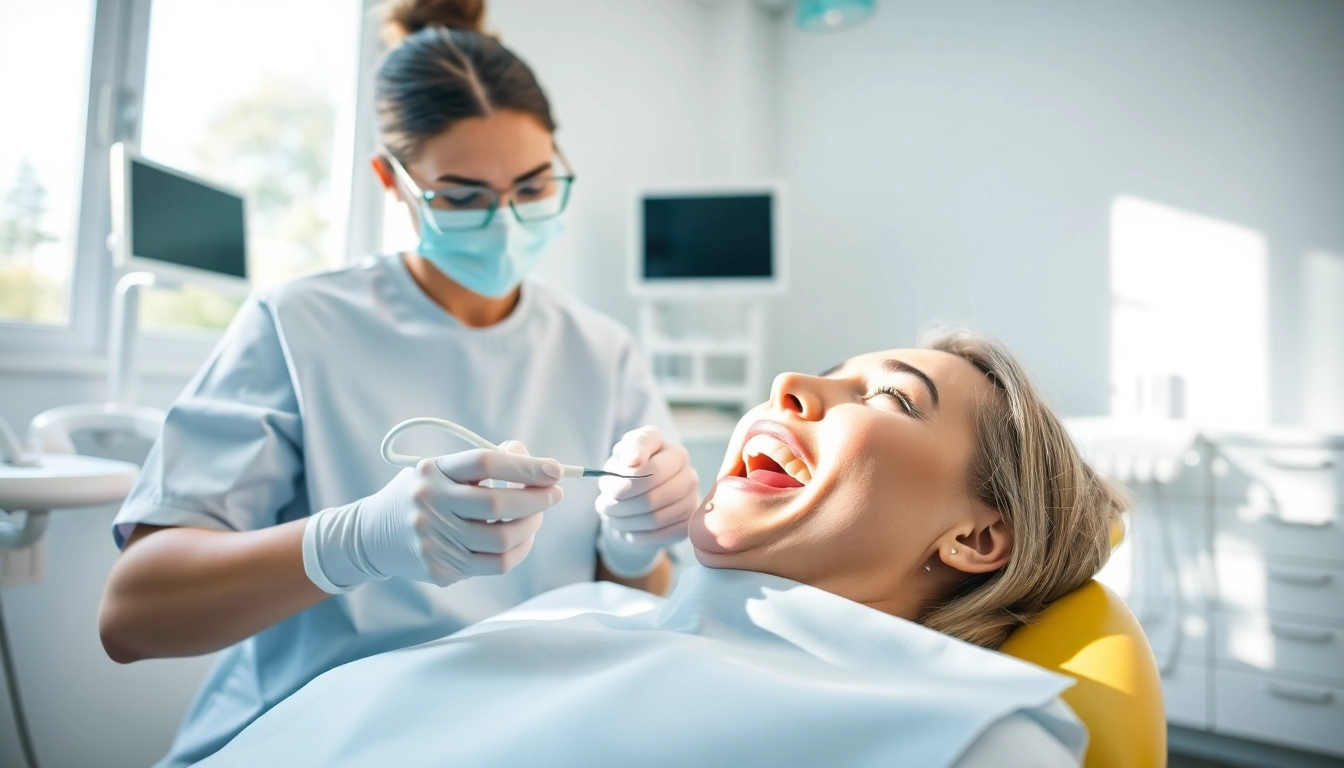Understanding Dental Cleanings
What Are Dental Cleanings?
Dental cleanings are routine procedures performed by dental professionals, including dentists and dental hygienists, aimed at maintaining optimal oral health. During a typical dental cleaning, a dental hygienist uses specialized tools to remove plaque, tartar, and bacteria that accumulate on the teeth and gums. This cleaning process not only preserves the health of your teeth but also prevents more serious dental conditions like cavities and gum disease. Regular dental cleanings are an essential practice that contributes to overall well-being and can enhance an individual’s self-confidence by promoting a brighter smile.
It’s important to have dental cleanings regularly scheduled, ideally every six months, aligning with the recommendations of the American Dental Association (ADA). By clicking on this dental cleanings link, you can learn more about how you can keep up with your dental health routine.
The Importance of Routine Dental Cleanings
Routine dental cleanings serve multiple functions beyond mere aesthetics. First and foremost, they minimize the risk of periodontal diseases, which can lead to significant discomfort, tooth loss, and other health complications. Removing built-up plaque and tartar helps to prevent gingivitis—a common form of gum disease marked by redness and swelling. Furthermore, these cleanings allow for early detection of dental issues before they escalate into more severe problems requiring extensive treatment, which can be both costly and painful.
Research shows that individuals who maintain regular dental cleaning routines are less likely to experience tooth decay and gum disease compared to those who do not. Studies suggest that regular dental visits can actually contribute to improved overall health, as there is growing evidence linking oral health to systemic diseases such as diabetes and heart disease. Thus, prioritizing regular cleanings is not just about maintaining a pretty smile but also about safeguarding overall health.
Common Myths About Dental Cleanings
Misunderstandings about dental cleanings can lead some individuals to postpone or avoid these important appointments. One common myth is that dental cleanings are necessarily painful. While some discomfort may occur, particularly if there is substantial tartar buildup, most cleanings are straightforward and minimally invasive, especially with modern techniques and professional care.
Another prevailing myth is that if you brush and floss regularly, dental cleanings are unnecessary. While good home care is crucial, it cannot replace the comprehensive cleaning performed by a professional. Certain areas in the mouth may be difficult to reach with a toothbrush or floss, and only a trained professional can ensure that these spots are thoroughly cleaned. It’s essential to debunk these myths to encourage more patients to seek the preventive care they need.
Types of Dental Cleanings
Regular Dental Cleanings Explained
Regular dental cleanings, also known as prophylaxis cleanings, typically take about 30 to 60 minutes and focus on the surfaces of your teeth above the gum line. During this cleaning, your dental hygienist will scale your teeth to remove plaque and tartar build-up. The process includes using a scaler, an ultrasonic instrument, and may involve polishing your teeth with a gritty toothpaste to give them a smooth, clean finish.
Patients might experience a mild sensation during this process, especially if they suffer from sensitive teeth. However, most people appreciate the clean feeling that comes afterward. Regular cleanings play a key role in preventative dentistry, keeping your oral cavity healthy and your overall health in check.
Deep Cleanings: When Are They Necessary?
Deep cleanings, or scaling and root planing, are typically recommended when a patient displays signs of periodontal disease. This type of cleaning goes beyond the gum line into the pockets formed between the gums and teeth where bacteria can thrive. Deep cleanings involve a more thorough process of cleaning the roots of the teeth as well as the dental pockets, which necessitates the use of anesthesia in some cases for patient comfort.
Indicators that a deep cleaning may be required include gum swelling, persistent bad breath, bleeding during brushing, or increased pocket depth between the teeth and gums. The goal of deep cleaning is to restore gum health and prevent further bone loss around the teeth. Patients are often instructed to follow up with additional dental visits for monitoring and maintenance.
Specific Conditions Requiring Specialized Cleanings
Certain oral health conditions necessitate specialized cleaning procedures. For example, patients diagnosed with diabetes or those undergoing cancer treatments may require tailored cleaning methods to accommodate their unique health circumstances. Individuals with periodontal disease may also benefit from more frequent cleanings, ensuring that their condition is effectively managed throughout the treatment process.
Furthermore, patients who wear braces or other orthodontic appliances may need specific cleaning protocols to prevent plaque accumulation around brackets and wires. In these cases, dental professionals may recommend certain tools or methods to facilitate effective cleaning and maintenance of oral hygiene.
The Dental Cleaning Process
Initial Examination and Assessment
The dental cleaning process typically begins with an initial examination and assessment. Before the cleaning, your dental hygienist will conduct a thorough evaluation of your oral health, which may include digital X-rays to identify hidden issues, such as cavities and bone loss. This diagnostic phase is critical since it allows the dental professional to customize the cleaning process according to your specific needs and situation.
During the assessment, the hygienist will check your teeth for signs of decay, inspect your gums for any indications of disease, and evaluate the fit and condition of dental restorations, if any have been placed. Understanding your medical history and current health status is also paramount as it influences the cleaning approach and any additional treatment necessary.
Tools and Techniques Used in Dental Cleanings
Various specialized tools and techniques are employed during dental cleanings to ensure optimal results. Some of the most common tools include:
- Scaling Tools: These hand-held instruments help to remove tartar and plaque from the tooth surfaces. Ultrasonic scalers may also be used, which create vibrations to help break up stubborn deposits.
- Polishing Tools: After scaling, a polishing tool is used along with a gritty paste to smooth the tooth surface, removing stains and polishing the enamel.
- Flossing Instruments: Dental hygienists often use specific flossing tools to ensure all areas between the teeth are cleaned effectively.
Each tool has a specific purpose, working together to ensure that both the surface and the spaces between teeth are thoroughly cleaned. Post-cleaning, fluorides or sealants may also be applied to protect the teeth and enhance remineralization.
Post-Cleaning Care and Recommendations
After a dental cleaning, patients are often provided with aftercare recommendations to maintain their oral health. These recommendations can include:
- Resuming regular brushing and flossing techniques, often with an emphasis on areas that require more attention.
- Adopting a balanced diet limiting sugar intake to prevent decay.
- Being mindful of signs of gum disease or dental problems that may arise between cleaning visits.
- Scheduling follow-up visits for any ongoing treatment necessary, especially if deep cleaning was performed.
By adhering to these recommendations, patients can significantly enhance their oral hygiene efforts and prolong their dental health between professional cleanings.
Benefits of Professional Dental Cleanings
Preventing Oral Diseases Through Dental Cleanings
One of the most significant benefits of professional dental cleanings is their effectiveness in preventing oral diseases. Regular cleanings help remove plaque—a soft, sticky film of bacteria that forms on your teeth. If not promptly removed, plaque can harden into tartar, which can lead to gum inflammation and periodontal diseases.
Continued neglect of oral hygiene can lead to severe conditions, including periodontitis, which has been linked to systemic health issues such as heart disease and diabetes. Professional cleanings significantly reduce these risks by ensuring that harmful bacteria are effectively removed and the health of your gums is routinely monitored.
Enhancing Aesthetic Appearance
Beyond health benefits, dental cleanings greatly enhance the aesthetic appearance of your teeth. Regular cleanings remove stains caused by food, beverages, or tobacco use, resulting in a brighter, more attractive smile. Polishing techniques used during cleanings contribute to this enhancement, making teeth appear shinier and healthier.
Many patients leave their cleaning appointments feeling rejuvenated and more confident in their smiles. This emotional and psychological boost is often an underrated benefit of regular dental cleanings.
Long-Term Savings on Dental Care
Investing in your oral health through routine dental cleanings can lead to long-term financial savings. The costs associated with treating advanced dental issues, such as root canals, extractions, and implants, far exceed the relatively modest expense of routine cleanings. By preventing serious issues early on, regular dental inspections and cleanings reduce the risk of costly and complex treatments later.
Additionally, those who maintain their oral health through preventative care may experience fewer dental emergencies, thereby reducing unexpected expenditures associated with urgent care visits.
Choosing the Right Dental Office for Cleanings
What to Look for in a Dental Practice
When selecting a dental office for cleanings, there are several factors to consider. You should look for a practice that is conveniently located and offers flexible scheduling options to accommodate your lifestyle. Additionally, the office should have modern equipment and follow the latest hygiene protocols, ensuring a safe and comfortable experience.
Researching the credentials and experience of the dental hygienists can also offer peace of mind. Reviews and recommendations from other patients can help you gauge the quality of care provided by the practice. Certifications from recognized dental organizations further affirm the expertise of the dental team.
Questions to Ask During Your First Visit
During your first visit to a dental practice, asking the right questions can set the stage for a positive ongoing relationship. Consider inquiring about:
- What are their standard cleaning procedures? Understanding the specific steps they take can put you at ease.
- What technologies do they use? Inquire about any advancements that may benefit your cleaning.
- How do they handle patient comfort and anxiety? Knowing their approach can help if you have concerns about dental visits.
This dialogue fosters transparency and helps establish a trustworthy relationship with your dental care provider.
Building a Relationship with Your Dental Hygienist
Establishing a good rapport with your dental hygienist is crucial. They play an essential role in your oral health journey and can provide personalized care recommendations tailored to your needs. Consider sharing your health history, any immediate concerns, and preferences regarding dental care during your visit.
Regular interactions during cleanings allow for this relationship to develop, leading to a more comfortable atmosphere during visits. Trust your dental hygienist as a partner in health—after all, they want you to enjoy optimal oral care.














Leave a Reply